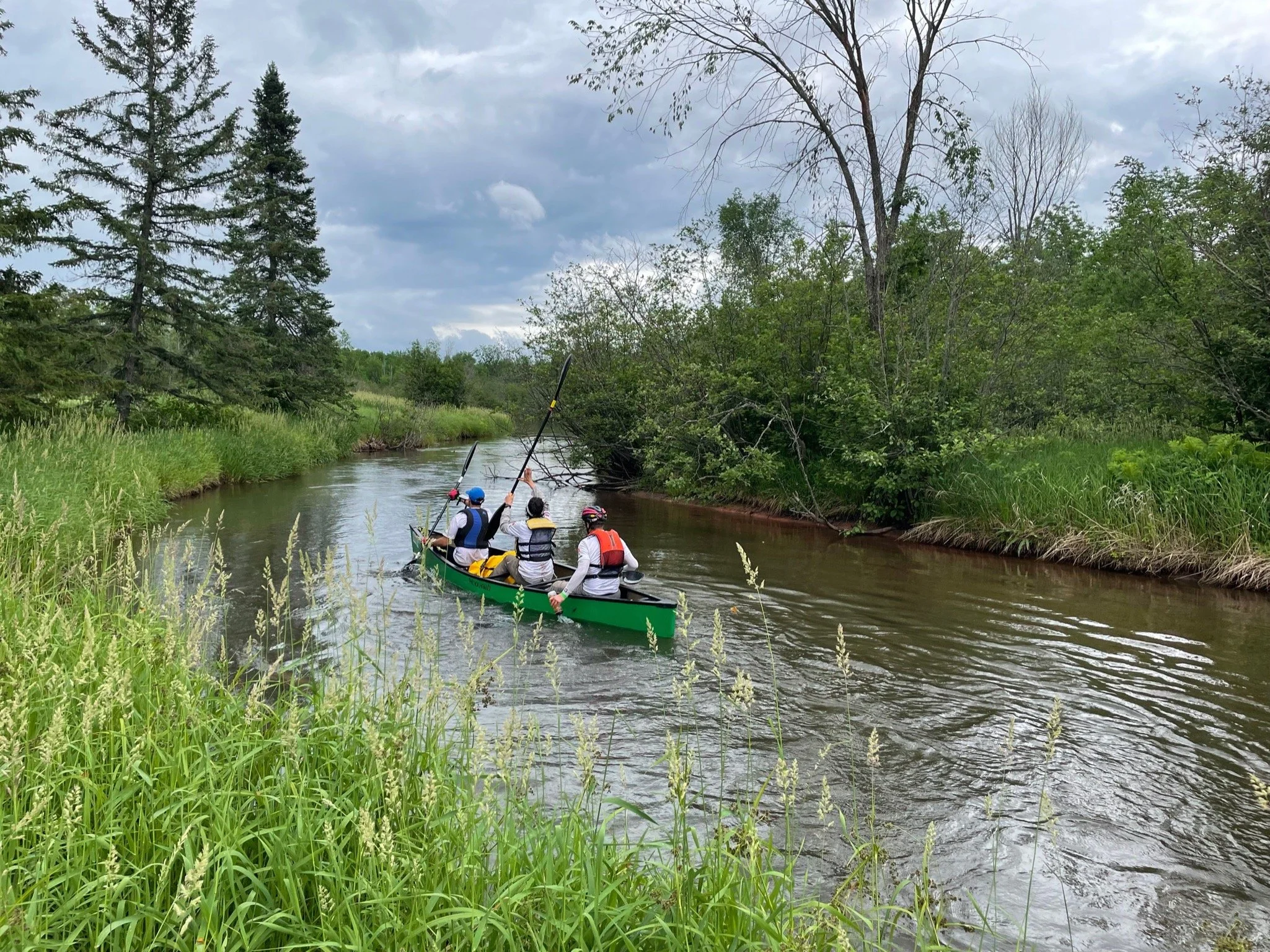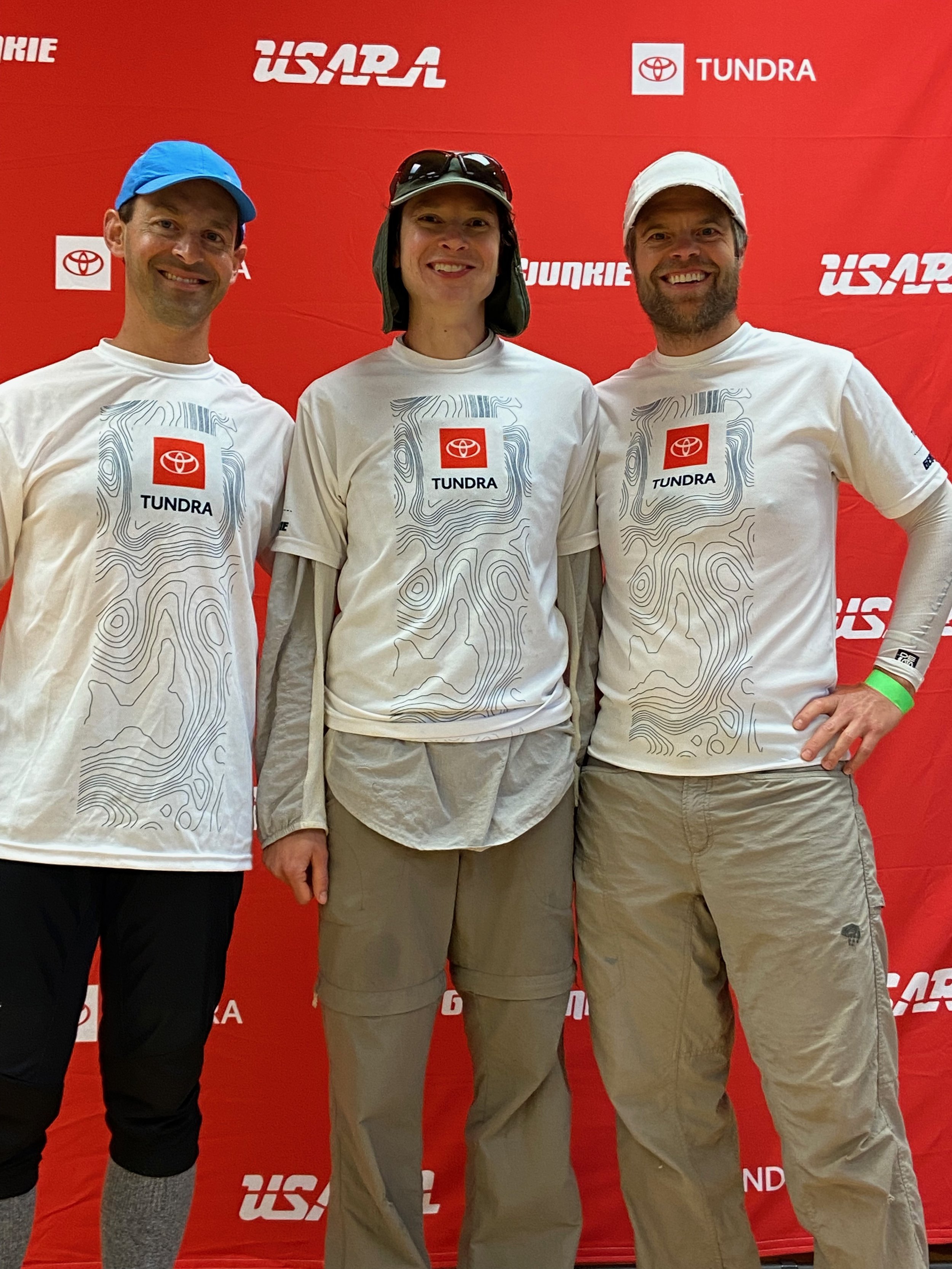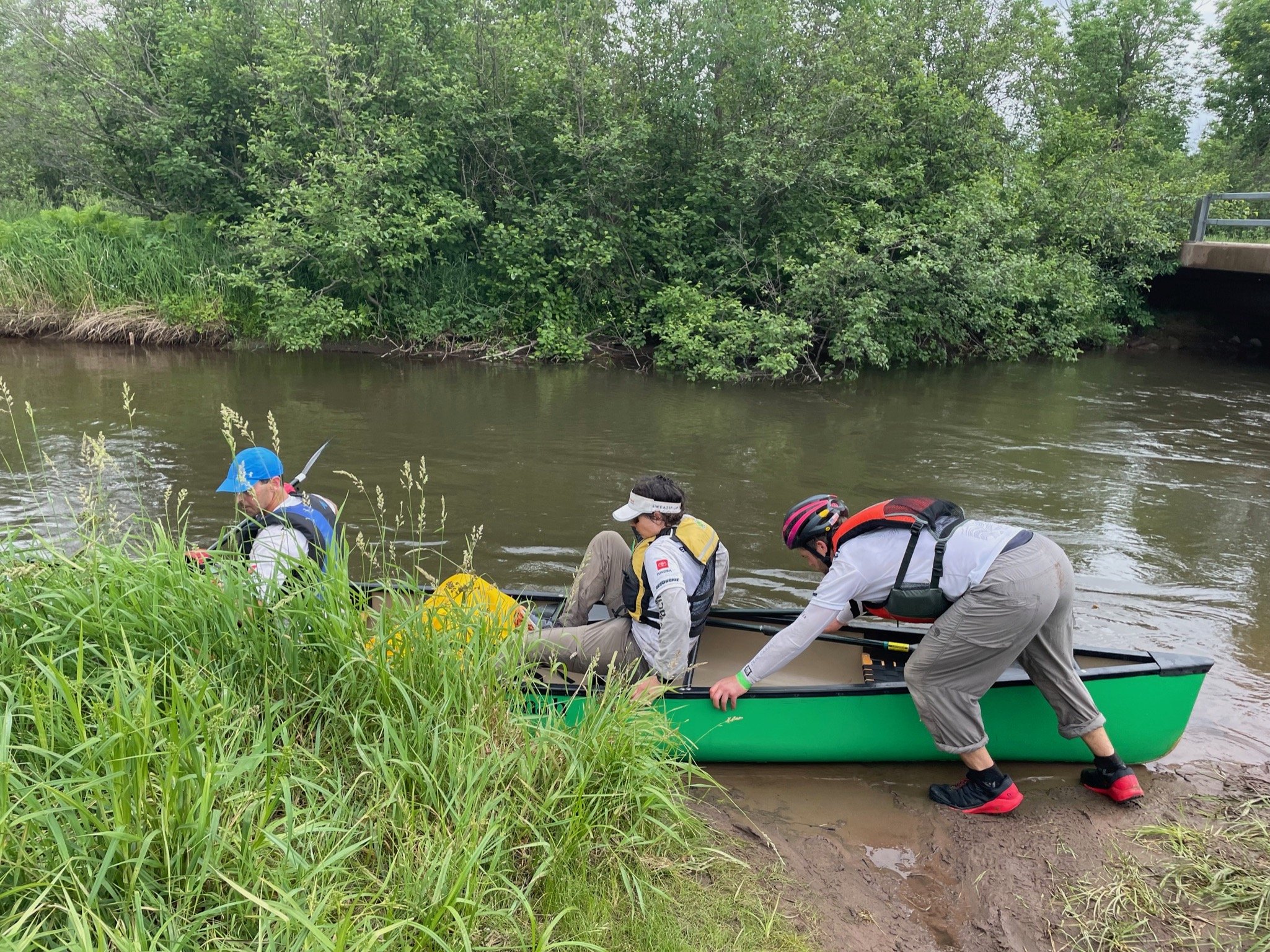Off the grid for 28 hours: Stubborn Mule 2022 race report
Before our adventure, bright-eyed and bushy tailed. Photo courtesy of 180 Adventure.
It’s not too often we can get off the grid but that’s what exactly what we did during the 2022 Stubborn Mule Adventure Race. Organized by 180 Adventure, the host of the 2021 USARA National Championship, the pre-race communications, course design, and experience as a whole were top-notch. I was filling in on Team Toyota Tundra, teaming up with the reigning national USARA champ, Justin, navigating, and Erik, with not-too-shabby back-to-back national USARA podiums. Erik and I frequently raced against Justin, which always raised the intensity of the race, but finally together for this adventure.
All we knew going in was that race headquarters was Drummond with a bike drop a few miles north along a forest road requiring a 3:45 am wake up. We had to stage our bikes a few miles north and get back to headquarters at 5 am to maximize our time to plan our next 30 hours of adventure. As we dropped off our bikes, not only had rain begun, but the mosquitos swarmed us. I just hoped it wouldn’t be this bad the entire race…at least there weren’t any deer flies.
Instead of a prologue, teams were spread out with a 15 minute start window before immersing into the Chequamegon-Nicolet National Forest. We were nearly always serenaded by the birds and frogs and when they finally fell silent we still had the hum of mosquitos to keep us company. We took off on a couple of easy miles running on the rail-to-trail overtaking a few teams that looked miserable swatting mosquitos. This was all the more motivation to maintain our pace. Shortly after dipping off trail, my feet were wet as we trekked across a bog. It wasn’t much longer before each of us slipped down a slope, were taken out by a hidden log, or ripped down from a snagged branch in the thick underbrush.
We soon spotted bear tracks, and I reminiscence how last year bears ripped down checkpoints in the woods. We nearly stepped on a yellow toad just chilling in the woods. We nabbed all the checkpoints efficiently and we were the first time to reach our bikes. We would now be carrying the remainder of our food with us less a couple hundred calories we stashed in our PFDs for the paddle. Luckily, I could stow about 15 hours of fuel on my bike. We took off on the surprisingly fast gravel, cruising over 20 kph.
The gravel riding was amazing – smooth, fast, and full of wilderness and wildlife! Photo courtesy of 180 Adventure.
Admittedly I am not a gravel biker and much rather be on singletrack than the roads, but the near absence of cars through the forest provided an intimate (yet speedy) experience. Altogether we covered about 70 miles of gravel in the race with about a few miles of pavement sprinkled in. Even though the race didn’t have any singletrack, the overgrown doubletrack required a best line to avoid all the sopping wet branches, providing a bit of a challenge. Nonetheless, I managed to end up dripping wet which really didn’t matter with the mild temps. We spotted large paw tracks and with the absence of foot tracks accompanying them, we suspected they were wolf tracks. More than once we saw a flying bowling ball, a turkey, that looked like it may not stay in flight to its intended destination.
It was a bit dicey in the boat as we entered the White River but we managed to stay in the boat. Photo courtesy of 180 Adventure.
We had another quick transition, this time to the paddle, but bobbled a bit as we pushed off into the White River. We managed to stay afloat. The marathon (literally 26 miles) of paddling the White River provided near-complete solitude. We serpentined around the countless bends frequently spotting waterfowl. Justin amazingly was able to track us on the map and even when he lost our location, he quicky sleuthed our location based on the direction of the brief straightaways. We attempted two portages on hairpin turns but decided that whittling 3 minutes of paddling wasn’t worth the risk of the uncertain portage conditions since we often could only see a few feet ahead due to the dense underbrush.
Justin skillfully nailed the four foot inlet that would save a mile plus of upstream paddling. I was happy to give my butt a break even though the alternative entailed slogging knee deep through mucky waters for several hundred meters. Erik and Justin pushed and pulled the boat while I trailed behind, happy that I didn’t lose a shoe. Justin even requested that we wash some of the mud off our shoes as we reloaded the boat after the canoe-whack.
As we headed upstream, we frequently ricocheted off the brushy banks in a sadistic game of pinball. I was especially thankful to be in the middle. The couple thumps on my head from Justin’s paddle was a small price compared to the work Erik and Justin did to navigate the turns. Plus I didn’t have to dodge branches as much as Erik in the bow. Progress was slow, but we took solace that the remainder of the paddle would be downstream once we obtained the two checkpoints. On our return route, we guesstimated our lead on the two other teams who we gave a friendly wave. As we returned to the main channel, we finally spotted a couple of other folks enjoying the beautiful water. Cliffs now adorned the banks as we now navigated a few rocks in the channel, two reasons to be grateful we got the paddle done in the remaining daylight hours. We were all ready to be done, and I awkwardly shifted in my seat as I had had enough sitting. The minutes seemed to take hours, but we finally passed under the trestle, which served as our signal that we were nearing the take out.
We were all happy to reach the first road access point since we had put our canoes in the water over six hours earlier. We hopped on our bikes that had been transported carefully and laid out. Volunteers sent us off with directions to the local bar for water fillups and even a hug. I attempted to shake out the silt from my shoe and sock but decided it wasn’t worth trying to do the second.
After filling up our water at the local bar and receiving several surprised looks when I answered how long we were racing, we exited the town into the countryside. I was surprised to be in farming country in the Northwoods. We spotted a black bear bounding at what I hope was full-speed across a field for a couple of hundred meters. I was awestruck at its endurance and speed. (It helped I was a safe distance away and on my bike as it looked like my speed and endurance would be no match.) At dusk, we saw deer in nearly every field we passed, with more than we could often count in the dimming light. Although we didn’t realize we had spotted a porcupine in the dark until we were past it, during the excellent post-race meal another racer shared her encounter with a porcupine and her cub as she stopped for ten minutes to marvel at the pair.
We flipped on our headlights and only encountered a single vehicle in the next three hours in the saddle. Once again, we were ready to be done with biking, as we had spent most of the past 14 hours sitting. We returned to our earlier bike drop where we would finally set out on foot. I was so appreciative to the volunteers that offered pulled pork and hot homemade mac-and-cheese. I took two bowls as I refilled water.
I’m glad that I topped off my bladder since what I was thinking would be three hours took us past daybreak due to the dense brush. We walked nearly the entire trek but Justin kept the night low drama and engaged us as much as possible. Justin was a storyteller, informing us as we’d go off trail that it would be so many meters before we’d hit the checkpoint which would be on the such-and-such hilltop/spur/entrants we went up/over/through. Despite this information, he’d point to it before I had the faintest idea of where it was for nearly every checkpoint.
I admire all navigators. I often struggle to maintain pace stumbling over rocks, roots, and logs, while they do all the work: breaking trail while reading a map with precision on the move. Above all, Justin’s gift for navigation was amazing to witness. Our third teammate never turned his headlamp on high and we never fanned out to search for a checkpoint.
Celebrating after 28 hours together off the grid. Photo courtesy of 180 Adventure.
At 3 am we were treated with a beautiful starlit sky with fireflies joining in. We stopped to marvel at the show with our headlamps off and gaze at the Big Dipper. As daybreak came to perk us up, so did the mosquitos. We doused ourselves in bug spray for the umpteenth time and trekked onward to our final checkpoints of the leg, wading through and down several creeks. Once I took off my pack and carried it above my head so my half-eaten food wouldn’t get waterlogged. I was lured by a second (and third) helping of mac-and-cheese and it was as good I had remembered in the prior transition. We still had several hours of trekking to go after a jaunt on the bike, so I didn’t want to pay for overindulging. (A good thing I left a little bit of room for the wild strawberries on the Drummond Ski Trails during our final trek!) We took off mainly on smooth pavement for the final trek. We had discussed the possibility of leaving some checkpoints but we were gifted our most open woods of the race. We were thankful we hadn’t left any earlier in the race, which is always a gamble, especially since we knew this trek would likely have the highest density of checkpoints on the course since it was used for the shorter races. With flawless navigation, we were able to clear the course and arrive back to race headquarters just north of 28 hours after nearly 150 miles off the grid.
After our adventure, sleepy-eyed but still pretty bushy tailed. Photo courtesy of 180 Adventure.
Upon arrival to the finish we were greeted with cheers and sunshine. The spread of post-race food was delicious (tacos with all the fixings with a huge spread of desserts). We enjoyed the camaraderie of the adventure racing community before attempting the drive back home. Justin fell asleep mid-meal but I wasn’t much better falling asleep midsentence on the ride home. With the help of naps, we all made it safely (and slowly) home to our families.
Later in the week, a post-race debriefing allowed all to share their insights on the day and the opportunity for new racers to ask veterans questions. Questions ranged from everything how to reapproach a missed checkpoint to how to pin a bib to prevent it from tearing off during bushwhacks. The sixty minutes quickly approached ninety minutes as we shared insights, questions, and stories!
Related posts:






